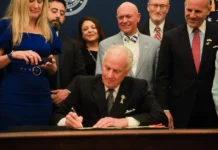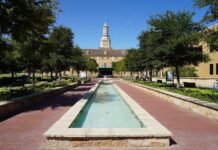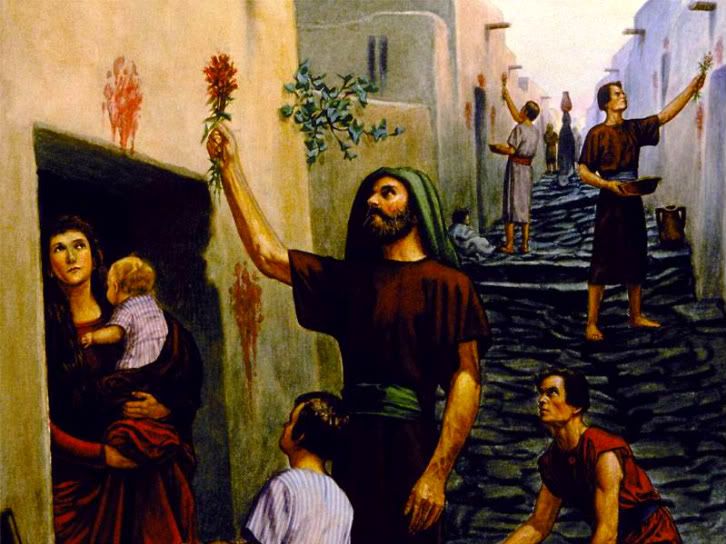During the first Passover after liberation, considerable numbers of the she’erith hapletah (the surviving remnant) came to the Munich area to celebrate in Sedarim in large and small Jewish Displaced Persons (DPs) camps, and at the Jewish hospital at St. Ottilien, noted Saul Touster, a professor of law. The Deutsches Theater Restaurant, a popular eatery frequented by Nazi officials, hosted Sedarim for 200 participants, including primarily survivors living outside the camps, together with a number of representatives of the Allied Forces, civilian government and relief agency personnel. At that point, there were about 6,000 of them. Haggadot were printed in Palestine, England and the U.S. Some were printed by the Jews themselves in Germany and Holland.
Among the Haggadot produced by the survivors, “The most finished in its extraordinary decorations and woodcuts, and the most comprehensive in paralleling Exodus and Holocaust,” was first published in Yiddish and Hebrew by Zionist groups Achida (United Zionist Organization for the Saved Remnant in Germany) and Nocham (United Pioneer Youth), which later became the “A” Haggadah. Yosef Dov Sheinson, arranged, designed, edited, chose the woodcuts and rewrote the classic opening line that established the tone and theme for the Haggadah: “We were slaves to Hitler in Germany.”
Rabbi Abraham Klausner
Shortly after publication of the Haggadah, Levi Shalit and Israel Kaplan, two editors of Unzer Weg (Our Way), which became the largest Yiddish weekly in Germany, took it to Chaplain Abraham Klausner, a Reform rabbi. In the first issue of Unzer Weg, Klausner, who had been instrumental in helping found the paper, was paid the highest tribute when the Shalit wrote “Rabbi, friend, brother, you have become one of us.” At a time when the survivors needed someone who understood who they were, what they had experienced and their need to control their own destiny, Klausner treated them with respect and dignity. He really had become one of them.
Klausner decided the Haggadah should be used for a Seder in Munich, which he would conduct. He wrote a two-page English introduction, and had the American army reprint the Haggadah through army press facilities using better paper. A new cover was designed with the tricolor insignia “A” for the U.S. Third Army of Occupation in Bavaria, with the date of April 15-16, 1946.
The texts of the Haggadah, Touster explained, “interweave with the traditional Passover liturgy, two stories unfold: that of the deliverance from Pharaoh in Egypt, and the Holocaust story of those Jews who survived Hitler.” When the time came for a child to ask the Four Questions, they realized there were no children in attendance. The room became silent, and people began to weep, until one man began the questioning and the rest joined him.
The text below uses the language of the Haggadah to proclaim God’s vengeance upon Egypt. In the 20th century, however, the retribution was not meted out by God, but by the Allied Forces.
“When the righteous among the nations saw that Hitler had decided to exterminate Israel, their great assembly came together and out of their great sorrow decided to keep them silent. Their tongues clove to the roofs of their mouths. And so they stood for a time like mourners with their heads bowed down (as is their custom when consoling mourners). All the while Hitler sets his hungry dogs at the babes of Israel, and they tear them to pieces. That evil man was also building gas chambers and crematoria in which to exterminate Israel. How great is the sorrow of the nations of the world! And the righteous among them say: How can we in our weakness save [Israel] from the hands of that evil man. Perhaps this is the hand of God, and who are we to interfere in the conduct of the world. And the people of Israel, in the attempt to save their children, hand them over to Christians to hide them. Some hide them for money; some, demanding money, hide them and later bring them out to be killed. And some hide them not for money, but out of conviction. And still others convert [the children] and turn them into idol worshippers. The fathers of these children are dragged by the murderers into camps, where they are made to perish by hard labor, by hunger and by all kinds of torture and disease. And the people see how Israel is swimming in their blood but they pass by. And the number of Israel diminishes slowly. The children of Israel groaned and cried out but they were not heard. And they cried to the Lord, the God of their fathers, who saw their suffering and oppression, and their cry went up … Finally, the enemies of the man of evil grew indignant, and they girded themselves and unleashed against that man of evil and his people great wrath, rage and fury.”
At the end of the war, “the surviving remnants were coming out of their caves, out of the forests, and out of death camps, returning to the lands of their exile. The people of those lands greeted them and said: ‘We thought you were no longer alive, and here you are, so many of you.’ And they sent the survivors all sorts of messages, telling them to leave the land, even killing them. And the people of Israel ran for their lives; they were sneaking across borders only to be robbed of everything they had. And they abandoned their monies and they saved their lives, and they went to Bavaria in order to go up to the Holy Land.”
A Final Note
During the Seder, we ask why we eat bitter herbs. The Haggadah responds by quoting from the Torah: “They [the Egyptians] embittered our lives with hard work.” In other words, the herbs remind us of the bitterness we experienced during our slavery in Egypt.
In “A Survivors’ Haggadah,” the answer was more poignant: “Because we were intoxicated by the incense of the galut [diaspora], because we fled from one galut [exile] to another, because we reassured ourselves saying: Ours will not be the fate that befell our people before us. Because we did little to help ourselves and reestablish our destroyed homes and country.”
Anger and animosity are not the pervasive message of the Haggadah. Instead, there is an almost mystical longing for the Land of Israel, to be achieved through the arduous efforts of the Zionists, not by God. At the center of Haggadah, Touster concludes, is “the call for an end of dissension, for unity among the Jews.”
*This essay is based on the work “A Survivors’ Haggadah” by Saul Touster, Ed. The Jewish Publication Society. 2000.
Dr. Grobman is the senior resident scholar at the John C. Danforth Society, a member of the Council of Scholars for Peace in the Middle East, and on the advisory board of The National Christian Leadership Conference of Israel (NCLCI). He lives in Jerusalem.


























